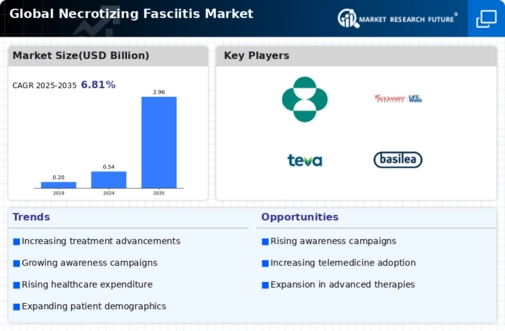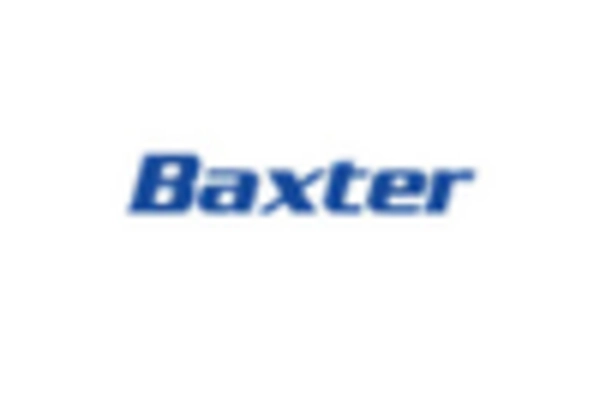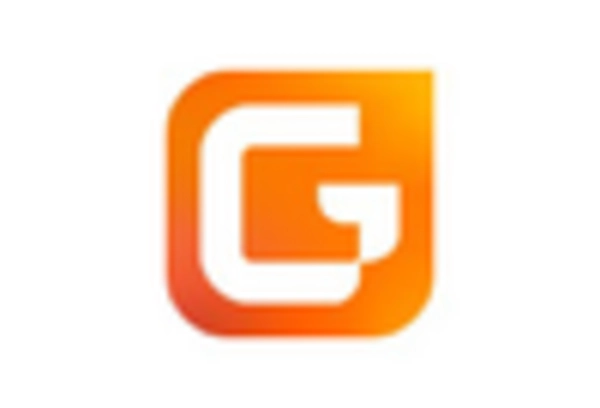-
Definition
-
Scope of the Study
- Research Objective
- Assumptions
- Limitations
-
Introduction
-
Primary Research
-
Secondary research
-
Market Size Estimation
-
Drivers
-
Restrains
-
Opportunities
-
Challenges
-
Macroeconomic Indicators
-
Technology Trends & Assessment
-
Porter’s Five Forces Analysis
- Bargaining Power of Suppliers
- Bargaining Power of Buyers
- Threat of New Entrants
- Threat of Substitutes
- Intensity of Rivalry
-
Value Chain Analysis
-
Investment Feasibility Analysis
-
Pricing Analysis
-
Chapter 6. Global Necrotizing Fasciitis Market, by Type
-
Introduction
-
Type I
-
Market Estimates & Forecast, 2020 – 2027
-
Type II
-
Market Estimates & Forecast, 2020 – 2027
-
Type III
-
Market Estimates & Forecast, 2020 – 2027
-
Others
-
Market Estimates & Forecast, 2020 – 2027
-
Chapter 7. Global Necrotizing Fasciitis Market, by Indication
-
Introduction
-
Intravenous Antibiotics
-
Market Estimates & Forecast, 2020 – 2027
-
Surgery
-
Market Estimates & Forecast, 2020 – 2027
-
Hyperbaric Oxygen Treatment
-
Market Estimates & Forecast, 2020 – 2027
-
Others
-
Market Estimates & Forecast, 2020 – 2027
-
Chapter 8 Global Necrotizing Fasciitis Market, by End User
-
Introduction
-
Hospital & Clinics
-
Market Estimates & Forecast, 2020 – 2027
-
Surgical Centers
-
Market Estimates & Forecast, 2020 – 2027
-
Others
-
Market Estimates & Forecast, 2020 – 2027
-
Chapter 9. Global Necrotizing Fasciitis Market, by Region
-
Introduction
-
Americas
- North America
- South America
-
Europe
- Western Europe
- Eastern Europe
-
Asia Pacific
- Japan
- China
- India
- Australia
- Republic of Korea
- Rest of Asia Pacific
-
The Middle East & Africa
- United Arab Emirates
- Saudi Arabia
- Oman
- Kuwait
- Qatar
- Rest of the Middle East & Africa
-
Chapter 10 Company Landscape
-
Introduction
-
Market Share Analysis
-
Key Development & Strategies
-
Chapter 11 Company Profiles
-
Merck
- Company Overview
- Product Overview
- Financials
- SWOT Analysis
-
WOCKHARDT
- Company Overview
- Product Overview
- Financial Overview
- Key Developments
- SWOT Analysis
-
Atox Bio
- Company Overview
- Product Overview
- Financial Overview
- Key Development
- SWOT Analysis
-
Teva Pharmaceutical Industries
- Company Overview
- Product/Business Segment Overview
- Financial Overview
- Key Development
- SWOT Analysis
-
Basilea Pharmaceutica Ltd.
- Company Overview
- Product Overview
- Financial overview
- Key Developments
-
MELINTA THERAPEUTICS, INC.
- Company Overview
- Product Overview
- Financial Overview
- Key Developments
-
Others
-
Chapter 12 MRFR Conclusion
-
Key Findings
- From CEO’s View Point
- Unmet Needs of the Market
-
Key Companies to Watch
-
Prediction of Healthcare Industry
-
Chapter 13 Appendix
-
LIST OF TABLES
-
Necrotizing Fasciitis Industry Synopsis, 2020 – 2027
-
Global Necrotizing Fasciitis Market Estimates and Forecast, 2020 – 2027, (USD Million)
-
Global Necrotizing Fasciitis Market by Region, 2020 – 2027, (USD Million)
-
Global Necrotizing Fasciitis Market by Type, 2020 – 2027, (USD Million)
-
Global Necrotizing Fasciitis Market by Indication, 2020 – 2027, (USD Million)
-
Global Necrotizing Fasciitis Market by End Users, 2020 – 2027, (USD Million)
-
North America Necrotizing Fasciitis Market by Type, 2020 – 2027, (USD Million)
-
North America Necrotizing Fasciitis Market by Indication, 2020 – 2027, (USD Million)
-
North America Necrotizing Fasciitis Market by End Users, 2020 – 2027, (USD Million)
-
US Market by Type, 2020 – 2027, (USD Million)
-
US Necrotizing Fasciitis Market by Indication, 2020 – 2027, (USD Million)
-
US Necrotizing Fasciitis Market by End Users, 2020 – 2027, (USD Million)
-
Canada Market by Type, 2020 – 2027, (USD Million)
-
Canada Necrotizing Fasciitis Market by Indication, 2020 – 2027, (USD Million)
-
Canada Necrotizing Fasciitis Market by End Users, 2020 – 2027, (USD Million)
-
South America Market by Type, 2020 – 2027, (USD Million)
-
South America Necrotizing Fasciitis Market by Indication, 2020 – 2027, (USD Million)
-
South America Necrotizing Fasciitis Market by End Users, 2020 – 2027, (USD Million)
-
Europe Market by Type, 2020 – 2027, (USD Million)
-
Europe Necrotizing Fasciitis Market by Indication, 2020 – 2027, (USD Million)
-
Europe Necrotizing Fasciitis Market by End Users, 2020 – 2027, (USD Million)
-
Western Europe Market by Type, 2020 – 2027, (USD Million)
-
Western Europe Necrotizing Fasciitis Market by Indication, 2020 – 2027, (USD Million)
-
Western Europe Necrotizing Fasciitis Market by End Users, 2020 – 2027, (USD Million)
-
Eastern Europe Market by Type, 2020 – 2027, (USD Million)
-
Eastern Europe Necrotizing Fasciitis Market by Indication, 2020 – 2027, (USD Million)
-
Eastern Europe Necrotizing Fasciitis Market by End Users, 2020 – 2027, (USD Million)
-
Asia Pacific Market by Type, 2020 – 2027, (USD Million)
-
Asia Pacific Necrotizing Fasciitis Market by Indication, 2020 – 2027, (USD Million)
-
Asia Pacific Necrotizing Fasciitis Market by End Users, 2020 – 2027, (USD Million)
-
The Middle East & Africa Market by Type, 2020 – 2027, (USD Million)
-
The Middle East & Africa Necrotizing Fasciitis Market by Indication, 2020 – 2027, (USD Million)
-
The Middle East & Africa Necrotizing Fasciitis Market by End Users, 2020 – 2027, (USD Million)
-
LIST OF FIGURES
-
Research Process
-
Segmentation for Global Necrotizing Fasciitis Market
-
Segmentation Market Dynamics for Global Necrotizing Fasciitis Market
-
Global Necrotizing Fasciitis market Share, by Type 2020
-
Global Necrotizing Fasciitis market Share, by Indication 2020
-
Global Necrotizing Fasciitis Market Share, by End Users, 2020
-
Global Necrotizing Fasciitis Market Share, by Region, 2020
-
North America Necrotizing Fasciitis Market Share, by Country, 2020
-
Europe Necrotizing Fasciitis Market Share, by Country, 2020
-
Asia Pacific Necrotizing Fasciitis Market Share, by Country, 2020
-
Middle East & Africa Necrotizing Fasciitis Market Share, by Country, 2020
-
Global Necrotizing Fasciitis Market: Company Share Analysis, 2020 (%)
-
Merck: Key Financials
-
Merck: Segmental Revenue
-
Merck: Geographical Revenue
-
WOCKHARDT. Key Financials
-
WOCKHARDT. Segmental Revenue
-
WOCKHARDT. Geographical Revenue
-
Bayer: Key Financials
-
Bayer: Segmental Revenue
-
Bayer: Geographical Revenue
-
Teva Pharmaceutical Industries: Key Financials
-
Teva Pharmaceutical Industries: Segmental Revenue
-
Teva Pharmaceutical Industries: Geographical Revenue
-
Basilea Pharmaceutica Ltd.: Key Financials
-
Basilea Pharmaceutica Ltd.: Segmental Revenue
-
Basilea Pharmaceutica Ltd.: Geographical Revenue
-
MELINTA THERAPEUTICS, INC.: Key Financials
-
MELINTA THERAPEUTICS, INC.: Segmental Revenue
-
MELINTA THERAPEUTICS, INC.: Geographical Revenue









Leave a Comment